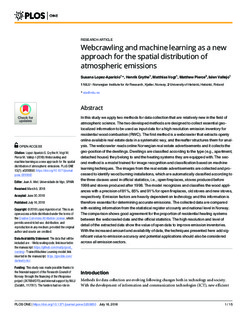| dc.contributor.author | Lopez-Aparicio, Susana | |
| dc.contributor.author | Grythe, Henrik | |
| dc.contributor.author | Vogt, Matthias | |
| dc.contributor.author | Pierce, Matthew | |
| dc.contributor.author | Vallejo, Islen | |
| dc.date.accessioned | 2018-08-01T07:49:02Z | |
| dc.date.available | 2018-08-01T07:49:02Z | |
| dc.date.created | 2018-07-31T10:20:58Z | |
| dc.date.issued | 2018 | |
| dc.identifier.citation | PLoS ONE. 2018, 13 e0200650 | |
| dc.identifier.issn | 1932-6203 | |
| dc.identifier.uri | http://hdl.handle.net/11250/2507065 | |
| dc.description.abstract | In this study we apply two methods for data collection that are relatively new in the field of atmospheric science. The two developed methods are designed to collect essential geo-localized information to be used as input data for a high resolution emission inventory for residential wood combustion (RWC). The first method is a webcrawler that extracts openly online available real estate data in a systematic way, and thereafter structures them for analysis. The webcrawler reads online Norwegian real estate advertisements and it collects the geo-position of the dwellings. Dwellings are classified according to the type (e.g., apartment, detached house) they belong to and the heating systems they are equipped with. The second method is a model trained for image recognition and classification based on machine learning techniques. The images from the real estate advertisements are collected and processed to identify wood burning installations, which are automatically classified according to the three classes used in official statistics, i.e., open fireplaces, stoves produced before 1998 and stoves produced after 1998. The model recognizes and classifies the wood appliances with a precision of 81%, 85% and 91% for open fireplaces, old stoves and new stoves, respectively. Emission factors are heavily dependent on technology and this information is therefore essential for determining accurate emissions. The collected data are compared with existing information from the statistical register at county and national level in Norway. The comparison shows good agreement for the proportion of residential heating systems between the webcrawled data and the official statistics. The high resolution and level of detail of the extracted data show the value of open data to improve emission inventories. With the increased amount and availability of data, the techniques presented here add significant value to emission accuracy and potential applications should also be considered across all emission sectors. | nb_NO |
| dc.language.iso | eng | nb_NO |
| dc.rights | Navngivelse 4.0 Internasjonal | * |
| dc.rights.uri | http://creativecommons.org/licenses/by/4.0/deed.no | * |
| dc.subject | Machine learning | |
| dc.subject | Webcrawling | |
| dc.title | Webcrawling and machine learning as a new approach for the spatial distribution of atmospheric emissions | nb_NO |
| dc.title.alternative | Webcrawling and machine learning as a new approach for the spatial distribution of atmospheric emissions | nb_NO |
| dc.type | Journal article | nb_NO |
| dc.type | Peer reviewed | nb_NO |
| dc.description.version | publishedVersion | nb_NO |
| dc.rights.holder | © 2018 Lopez-Aparicio et al. | nb_NO |
| dc.source.pagenumber | e0200650 | nb_NO |
| dc.source.volume | 13 | nb_NO |
| dc.source.journal | PLoS ONE | nb_NO |
| dc.identifier.doi | 10.1371/journal.pone.0200650 | |
| dc.identifier.cristin | 1599108 | |
| dc.relation.project | Norges forskningsråd: 247884 | nb_NO |
| dc.relation.project | NILU - Norsk institutt for luftforskning: 115070 | nb_NO |
| cristin.unitcode | 7460,54,0,0 | |
| cristin.unitcode | 7460,53,0,0 | |
| cristin.unitname | By og industri | |
| cristin.unitname | Software- og hardwareutvikling | |
| cristin.ispublished | true | |
| cristin.fulltext | original | |
| cristin.qualitycode | 1 | |

